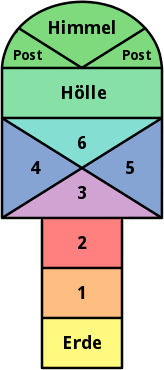Hickelkasten

Hickelkasten or Himmel und Hölle is a jumping game for which there are numerous landscape names, for example Hopse (Berlin), Tempelhupfen (Tyrol), Humpelchen ( Western Pomerania), Hippelheisje (Saarbrücken), Journey to the Moon , Paradiesspiel , Hinkekasten , Hüpfe- , Huppe - or Hüppekasten , Hickelsches , Hickeln , Hasehoppeln , Hipferihoppedi , Hickerles , Hinkepinke or Hinkeln .
Heaven and Hell is a simple children's game that can be played with any number of participants, but also alone. Together with the rubber twist , it is a common jumping game in schoolyards .
distribution
You can find this game almost everywhere in the world in a multitude of variants. Game researchers found that children in Burma hopped on a similar chart to children in the United States. In Germany and Holland alone, 20 different Hickel case patterns were found in investigations. In some countries children jump in a stooped position (common in Southeast Asia), in others with their hands on their hips (Africa).
The origin of the game is uncertain. One of the oldest surviving Hickel diagrams was found on the floor of the ancient forum in Rome , probably scratched with a stone. With their road network, which stretched from Asia Minor to Northern Europe, the Romans created ideal surfaces for jumping games. This may have contributed to its widespread use. Since archaeologists can not find lines drawn in the earth centuries ago, the history of worldwide distribution and the age of the game remain in the dark.
regulate
The rules of this children's game are as varied as the patterns, which are mostly carved into the ground, but in cities also with chalk or a painting stone in the asphalt or concrete of the street. Common to all variants is the throwing stone previously selected by each participant . The choice usually falls on a flat stone that does not roll too much after the throw. Instead of the stone, parts of chains or bracelets are also used.
Simple variant
In a simple, widespread variant, the stone must be thrown from field 1 to field 9. If you hit the corresponding field, you start to jump (to hitchhike), that is, to jump on one leg. However, the field with the throwing stone is skipped. Fields 4 and 5 are entered with both legs, only to land on one leg again in field 6. Fields 7 and 8 are again to be completed with both legs, just like the last field 9 (often called the sky ). Then you do a half turn, land again with both legs on 9 and now come back to the beginning with a hitch. In the field in front of the throwing stone it has to be collected. Depending on the variant, the game is divided into rounds, i.e. at the beginning of the next round the stone must be thrown one space further than in the previous round. Whoever threw into the last field first and jumped correctly wins. If you make a mistake when throwing (stone lands outside or on the line of the selected field) or jump (you step on the border, forgets to jump, forgets the stone when reversing or if you lose your balance and have to touch the ground with both feet touch an unauthorized spot), the next player's turn immediately.
Heaven and Hell variant
In this variant, the first field is labeled with the word “earth”, the penultimate with “hell” and the last with the term “heaven”. Usually the earth is the starting point. The hell is basically to skip, that is, they must not be entered. In some variants there are post fields , if the stone lands here, it is no longer allowed to speak or laugh, which of course makes the other players even more tempting to induce the participant to do so. Depending on the variant, the throwing stone is kicked into the next field with each jump or not thrown at all, but carried in various ways while jumping (e.g. on the foot or head). You can also specify the foot with which the fields can be jumped. In Switzerland the term Hickelkasten is hardly known, here the game is usually called heaven and hell . In contrast to the variant with the “Earth” field, hell is often at the bottom and heaven at the top of the game. In Vienna the game is known under the name “Temple Hopping”, while “Heaven and Hell” is usually understood as another children's game.
Hop snail (snail hopping)
The fields are arranged in the form of a snail, on which you hop all around from the outside to the inside. It can be agreed that afterwards you have to jump from the inside out.
meaning

A cosmological, at least calendar-related, original meaning of the game was assumed by numerous ethnologists, see most recently Friedrich Hirsch with a collection of various hopping figures.
literature
- FV Grunfeld, Eugen Oker : Games of the world . Fischer Verlag, 1986.
Web links
Individual evidence
- ↑ Hopping games website with several Hinkekasten variants.
- ↑ Friedrich Hirsch : The solstice arch . Ernst Kaufmann, Lahr in the Black Forest, posthumously 1965, plates 31–35.



